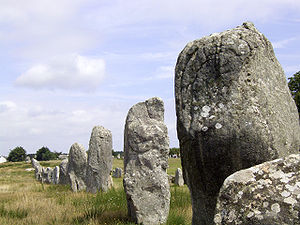Carnac

Carnac is a French town, 20 miles southeast of Lorient, near which are extensive alignments of megaliths, a dolmen, and two barrows. The monuments are believed to be of late stone age origin.
The principal group of menhirs is situated on a moor near the seashore, and consists of 1,000 or more granite monoliths, resting with their smaller ends in the ground, rising, many of them to a height of 18 feet, though large proportion do not exceed 3 feet. They are arranged in 11 roughly parallel rows, with two slight breaks, extend from east to west about 1¼ mile in length, and have at one end a curved row of 18 stones, the extremities of which touch the outer horizontal rows.
The origin and object of the monument remain a mystery. Small monuments of the same character as the great one at Carnac are found to the west of it at Endeven and St Barbe. The Bossenno, a group of mounds, about 1½ miles from Carnac, otherwise called "Caesar's Camp," contains the principal Roman remains and was first explored systematically in 1874–1880. The result was the discovery of buildings giving evidence of the existence of a Gallo-Roman settlement at the Bossenno. Numerous remains were found consisting chiefly of pottery (some of it very fine), tiles, bronze and iron objects, fine glassware, Roman coins, statuary, and food refuse. While most of the pottery is evidently of Gaulish and Roman origin, many of the bronze ornaments are of Celtic type, and the coins all Roman, with dates from 200 to 353 AD.
